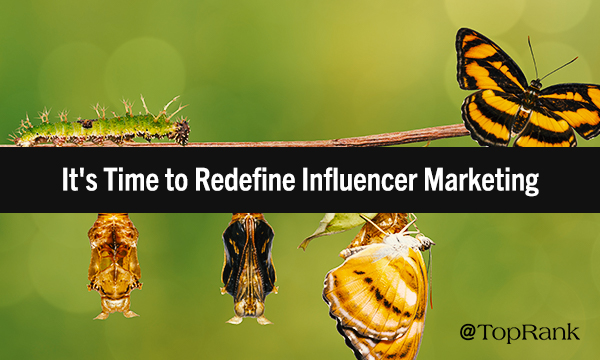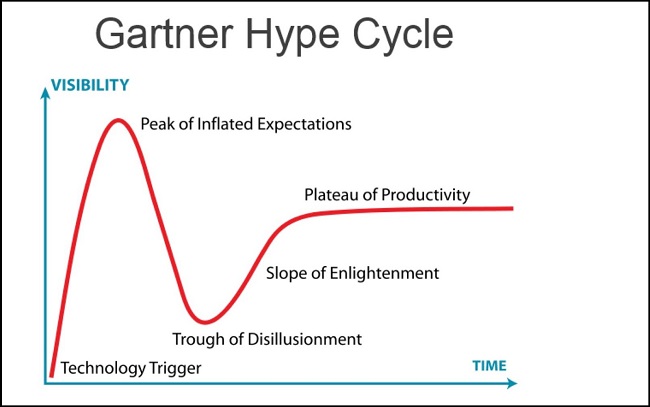Beyond the Hype Cycle: It’s Time to Redefine Influencer Marketing

 Every marketer should consider getting a tattoo of Gartner’s Hype Cycle, as a reminder to keep us from chasing shiny objects.
Every marketer should consider getting a tattoo of Gartner’s Hype Cycle, as a reminder to keep us from chasing shiny objects.  The Hype Cycle goes like this:
The Hype Cycle goes like this:
- A new hotness emerges. It could be new technology, a new strategy or tactic, some new thing.
- There are wild predictions about how the thing will revolutionize the world.
- People scramble to get on board with the thing before they even understand it.
- The new thing doesn’t measure up to elevated expectations.
- People get disillusioned with the thing and decide it’s worthless.
- People actually learn how the thing works, get sophisticated in using it.
- The thing turns out to be pretty awesome and is used productively.
#1 - Redefining Influence
In the B2C world (and even in the B2B realm), influence and celebrity are often treated as synonyms. Whether it’s Rhianna or Matthew McConaughey or Pewdiepie, it’s people who have audiences in the millions. There’s some differentiation for relevancy — this YouTuber does makeup tutorials, that one is a gamer — but it’s mostly a numbers game. It’s paying people with huge followings to throw some attention at your brand. As Ursula Ringham, Head of Global Influencer Marketing for SAP*, told us in a recent interview on social and influencer marketing:"People often think that influencer marketing is all about celebrities hawking a product. It’s truly not about that—especially in the B2B realm. It’s about highlighting experts who have real experience on the business challenges a brand’s audience faces."To become more sophisticated, you need to rethink what it means to be influential. Sure, a mega-star with a huge following is great — if they are relevant to your specific target audience and if their participation doesn’t break the bank. However, you can get amazing results working with influencers like:
- Thought leaders in the industry with a small but prestigious network
- Experts with radical new ideas who are poised to become thought leaders
- Subject matter experts within your own company
- Prospective customers from influential brands you want to work with
- Employees who will advocate for your brand given direction and material
“Social marketers in 2018 see the value in employee advocacy as a cost-effective, scalable alternative to influencer marketing.”I would say “addition” rather than “alternative,” but it’s definitely an undervalued tactic. Our experience is that a combination of industry and internal influencers can yield the most effective results. SAP Success Factors incorporated industry influencers, internal subject matter experts, partners and clients on a program that exceeded the lead generation goal by 272% with a 66% conversion rate. The bottom line is, when evaluating influencers, look beyond their follower count. Their industry reputation, group affiliations, and level of engagement are all indicators influence, too. And don’t forget to include your customers, prospects, and employees in your potential influencer pool. [bctt tweet="When evaluating influencers, look beyond their follower count. Their industry reputation, group affiliations, & level of engagement are all indicators influence, too. - @NiteWrites #RedefiningInfluencerMarketing" username="toprank"]
#2 - Redefining Compensation
The rising cost of influencer marketing is another factor that has led to the trough of disillusionment. The majority of influencer marketing, especially in B2C, has been exclusively transactional. Big brands swept up top-tier influencers, the payments kept getting bigger for smaller results, and eventually the bubble had to burst. To reach the plateau of productivity, that compensation model must change. At TopRank Marketing, we focus on building relationships with influencers and invite them to co-create with us. While there are instances in which financial compensation is part of the partnership, most often the compensation is the same both for our client and the influencer:- A cool, valuable asset to share
- Cross-promotion to each other’s audiences
- Boost to thought leadership
- Access to a community of thought leaders
#3 - Redefining Measurement
Proving ROI is a crucial part of making your influencer marketing more sophisticated. Without the ability to show what your influencers have accomplished for the brand, it’s hard to sell management on continued investment. It all starts with measurable goals and KPIs that hold your influencer marketing to the same standards as every other tactic you use. Tracking performance against those goals is the next step. We all have access to the tools and tech for this kind of measurement. We just need to use them more effectively to show how influencers are effective throughout the entire buyer’s journey. Right now, marketers tend to focus on the top of funnel metrics, because they’re easy to measure: Social reach, influencer participation, engagements, likes, comments. You need to get more granular than just those raw engagement numbers. You need to get from engagement to action. When you’re ready to amplify, give each influencer a custom URL to share. Then you can measure which influencers are actually inspiring people to leave social media and check out the asset you’ve created. From there, you can measure how those clicks convert to a lead capture, and track the lead through your pipeline. [bctt tweet="We all have access to the tools & tech for better measurement of #influencermarketing #ROI. We just need to use them more effectively. - @NiteWrites #RedefiningInfluencerMarketing" username="toprank"]Redefining Influencer Marketing
It’s time for influencer marketing to graduate from the Hype Cycle and become a trusted part of your integrated marketing strategy. To get to the plateau of productivity, we must discard what doesn’t work, keep what does, and refine our approach for continued improvement. It starts with reconsidering just what influence means and who has it. Once you find your true influencers, it’s about developing relationships and building communities, rather than ever-more-expensive transactions. Finally, it requires making your measurement as sophisticated as it is for the rest of your marketing tactics. We have found that influencer marketing beyond the Hype Cycle is an indispensable part of our marketing mix. The proof is in the pie: Read how our Easy-As-Pie Guide to Content Planning drove a 500% increase in leads for client DivvyHQ. *Disclosure: SAP and LinkedIn are TopRank Marketing clients.The post Beyond the Hype Cycle: It’s Time to Redefine Influencer Marketing appeared first on Online Marketing Blog - TopRank®.
Share from Online Marketing Blog – TopRank®
Beyond the Hype Cycle: It’s Time to Redefine Influencer Marketing
 Reviewed by mimisabreena
on
Monday, June 18, 2018
Rating:
Reviewed by mimisabreena
on
Monday, June 18, 2018
Rating:
 Reviewed by mimisabreena
on
Monday, June 18, 2018
Rating:
Reviewed by mimisabreena
on
Monday, June 18, 2018
Rating:
















No comments:
Post a Comment